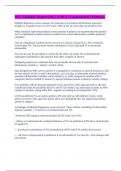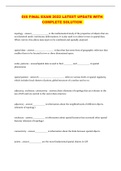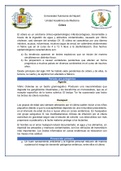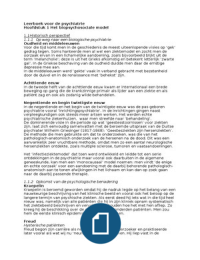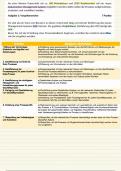Chapter 1. Exploring the strategy Framework
1.1Introduction
1.2What is strategy?
Strategy is the long-term direction of an organisation. Example: Disney from
cartoons to diversified entertainment. In the end becomes an organisation’s
strategy, a ‘strategy statement’.
1.2.1 Defining strategy
Strategy is defining as ‘the long-term direction of an organisation’. Two advantages:
1. can include both deliberate, logical strategy and more incremental, emergent
patterns of strategy
2. can include both strategies that emphasise difference and competition, and
strategies that recognize the roles of cooperation and even imitation
Three elements of this strategy definition can be further explored:
1. The long term: the three-horizons framework suggests organisations should
think of themselves as comprising three types of business or activity defined
by their ‘horizons’ in terms of years.
Horizon 1: Current core activities – extend and defend these activities.
Horizon 2: Develop emerging activities – to generate new sources of growth and/or
profit.
Horizon 3: Create viable strategic options for the future – higher risk activities that
may take years to generate
growth/profits.
Page 1 of 95
, 2. Strategic direction: over de years, strategies follow some kind of long-term
direction of trajectory
3. Organisation: organisations are not treated as discrete, unified entities.
Organisations involve many relationships, both internally and externally
(internal and external stakeholders).
Internally: organisations are filled with people, typically with diverse,
competing and more or less reasonable views of what should be done
Externally: organisations are surrounded by important relationships, example:
suppliers, customers, alliance partners, regulators and investors.
Strategy involves managing people, relationships and resources, and is sometimes
called ‘strategic management’.
1.2.2 The purpose of strategy: mission, vision, values and objectives
The core of a strategist’s job is defining and expressing a clear and motivating
purpose for the organisation. The stated purpose of the organisation should address
two related questions:
1. How does the organisation make a difference?
2. For whom does the organisation make the difference?
If the stakeholders of an organisation can relate to such a purpose, it can be highly
motivating.
Organisations typically define their purpose in four ways:
1. A mission statement aims to provide employees and stakeholders with
clarity about what the organisation is fundamentally there to do
2. A vision statement is concerned with the future the organisation seeks to
create
3. Statements of corporate
values communicate the
underlying and enduring core
‘principles’ that guide an
organisation’s strategy and
define the way that the
organisation should operate
4. Objectives are statements of
specific outcomes that are to
be achieved
1.2.3 Strategy statements
Strategy statements should have 3
main themes:
The fundamental goals (mission,
The scope or domain of the organisation activities; and the particular advantages
or capabilities it has to deliver all of these.
Page 2 of 95
,Scope: an organization’s scope or domain refers to three dimensions: customers or
clients; geographical location; and extent of internal activities (‘vertical integration’).
Advantage: this part of a strategy statement describes how the organisation will
achieve the objectives it has set for itself in its chosen domain.
1.2.4 Levels of strategy
So far we have considered an organisation as a whole, but inside an organisation,
strategies can exist at three main levels.
1. Corporate-level strategy is concerned with the overall scope of an
organisation and how value is added to the constituent businesses of the
organisational whole.
Diversifying from the organisation’s original activities into other activities (e.g. Tesla
selling batteries for home use).
Which goal?
How create value?
Which markets?
Which diversity of products? How to distribute resources?
2. Business-level strategy is about how the individual businesses should
compete in their particular market.
Marketing and product improvement strategies (e.g. developing a lower cost,
volume car for Tesla).
How to be competitive in specific markets?
3. Functional strategies are concerned with how the components of an
organisation deliver effectively the corporate- and business-level strategies in
terms of resources, processes and people.
Tesla’s functional strategies are geared to meeting its investment needs and raising
finance.
How to configure processes, people and resources?
This need to link the corporate, business and functional levels underlines the
importance of integration in strategy. Each level needs to be aligned with the
others. The demands of integrating levels define an important characteristic of
strategy: strategy is typically complex, requiring careful and sensitive management.
Strategy is rarely simple.
Page 3 of 95
,1.3The exploring strategy framework
The Exploring Strategy Framework includes understanding the strategic position
of an organisation; assessing strategic choices for the future; and managing
strategy in action.
1.3.1 Strategic position
the strategic position is concerned with the impact
on strategy of the macro-environment, the industry
environment, the organization’s strategic capability
(resources and competences), the organization’s
stakeholders and the organization’s culture.
Fundamental questions for Strategic position:
What are the macro-environmental opportunities
and threats?
How can the organization manage industry forces?
How are stakeholders aligned to the organisational
purpose?
What resources and capabilities support the
strategy?
How does culture fit the strategy?
1.3.2 Strategic choices
Strategic choices involve the options for strategy in
terms of both the directions in which strategy might
move and the methods by which strategy might be
pursued.
Fundamental questions for Strategic choice:
How should individual business units
compete?
Which businesses to include in the portfolio?
Where should the organization compete internationally?
Is the organisation innovating appropriately?
Should the organization buy other companies, form alliances or go it alone?
1.3.3 strategy in action
Managing strategy in action is about how strategies are
formed and how they are implemented.
Fundamental questions for Strategy in action:
Which strategies are suitable, acceptable and
feasible?
What kind of strategy-making process is needed?
Page 4 of 95
, What are the required organisation structures and systems?
How should the organization manage necessary changes?
Who should do what in the strategy process? Which people and what
activities?
1.4 Working with strategy
All managers are concerned with strategy:
Top managers frequently formulate and control strategy but may also involve
others in the process.
Middle and lower level managers have to meet strategic objectives and deal
with constraints.
All managers have to communicate strategy to their teams and can
contribute to the formation of strategy through ideas and feedback.
Organisations may also use strategy specialists:
Many large organisations have in-house strategic planning or analyst roles.
Strategy consultants can be engaged from management consulting firms (e.g.
Accenture, IBM Consulting, PwC).
There are a growing number of specialist strategy consulting firms (e.g.
McKinsey & Co., The Boston Consulting Group).
Strategy, therefore, is not just about abstract organisations. It is about linking
analysis with implementation on the ground. It is complex work that real people do.
1.5 Studying Strategy
The three branches and the characteristic analytical approaches of their main
research streams are as follows:
Strategy context refers to multiple layers of environment, internal and
external to organisations
Strategy content concerns the content (or nature) of different strategies
and their probability of success (strategic options).
Page 5 of 95
, Strategy process, broadly conceived, examines how strategies are formed
and implemented.
1.6 Exploring strategy further
Strategic issues are typically complex. There is no simple, universal rule for good
strategy. This section introduces two ways of exploring strategy: one depending on
context, the other depending on perspective.
1.6.1 Exploring strategy in different contexts
The Exploring Strategy Framework can be applied in many contexts, strategic issues
differ:
o Small businesses (e.g. strategic purpose, growth issues and retaining
independence).
o Multinational corporations (e.g. geographical scope; cultural issues and
structure/control issues).
o Public sector organisations (e.g. service/quality and managing change
issues).
o Not-for-profit organisations (e.g. purpose and funding issues).
As the next section will indicate, it is often helpful therefore to apply different lenses
to strategy problems
1.6.2 Exploring strategy through different ‘strategy lenses’
The strategy lenses are ways of looking at strategy issues differently in order to
generate additional insights. The strategy lenses are:
Strategy as design views strategy development as ‘designed’ in the abstract,
as an architect might design a building using pens, rulers and paper
Strategy as experience recognizes that an organisation’s future strategy is
often heavily influenced by its experience and that of its managers
The variety lens sees strategy as emergent from within and around
organisations as new ideas bubble up through an unpredictable process in
response to an uncertain and changing environment
Strategy as discourse focuses attention on the way’s managers use
language to frame strategic problems, make strategy proposals, debate
issues and then finally communicate strategic decisions
Page 6 of 95


